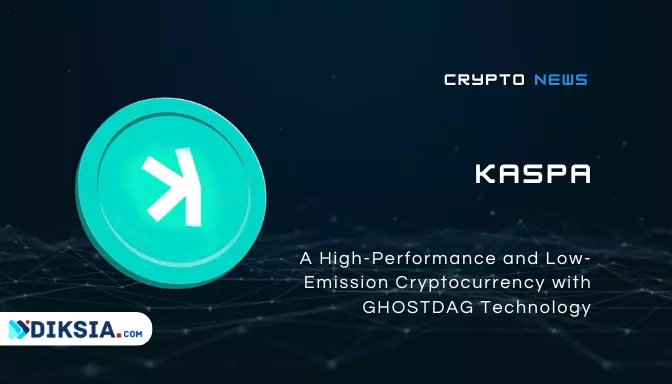Introduction
Diksia.com - Kaspa is a proof-of-work cryptocurrency that implements the GHOSTDAG protocol1. Unlike traditional blockchains, GHOSTDAG does not orphan blocks created in parallel, rather allows them to coexist and orders them in consensus. The Kaspa blockchain is actually a blockDAG, a generalization of Nakamoto consensus that allows for secure operation while maintaining very high block rates (currently one block per second, aiming for 10/sec, dreaming of 100/sec) and minuscule confirmation times dominated by internet latency.
The Kaspa implementation includes a lot of cool features such as Reachability to query the DAG’s topology, Block data pruning (with near-future plans for block header pruning), SPV proofs, and later subnetwork support which will make future implementation of layer 2 solutions much easier.
Kaspa also has a unique monetary policy that decreases emissions geometrically over time based on the 12-note scale of music. Known as the chromatic phase, this policy activated on May 7th 2022 with a block reward of 440 KAS. The block reward will be halved once per year, but smoothly: every month, the block reward is reduced by a factor of (1/2)^(1/12). This means that the ratio of block rewards in consecutive months is exactly the same as the ratio of frequencies of two consecutive semitones in a tempered chromatic scale. The initial block reward is the frequency of the note A4, and every averaged year is hence called an octave.
Kaspa Details
| Name | Kaspa |
|---|---|
| Symbol | KAS |
| Algorithm | SHA-256 |
| Consensus | GHOSTDAG |
| Block Time | 1 second |
| Block Reward | 440 KAS (initial) |
| Halving | Every month by a factor of (1/2)^(1/12) |
| Max Supply | 28,704,026,601 KAS |
| Circulating Supply | 21,808,366,099 KAS |
| Market Cap | $3,039,926,116 USD |
| Trading Volume | $46,435,882 USD |
What is Kaspa?
Kaspa is a cryptocurrency that aims to provide a fast, secure, and scalable transaction layer for decentralized applications. It is based on the GHOSTDAG protocol, which is a novel way of ordering blocks in a DAG (directed acyclic graph) structure. A DAG is a network of nodes that have edges pointing in one direction, forming a tree-like structure without cycles. Unlike a blockchain, which is a linear chain of blocks, a DAG can have multiple branches of blocks that are created in parallel by different miners. This allows for higher throughput and lower latency, as transactions can be confirmed faster and more frequently.
However, a DAG also poses a challenge for achieving consensus, as there is no clear way of determining the order of blocks and transactions in the network. This is where GHOSTDAG comes in. GHOSTDAG is a protocol that assigns a unique order to the blocks in the DAG, using a combination of two rules: the blue rule and the red rule. The blue rule selects the blocks that have the most accumulated proof-of-work behind them, forming a virtual chain of blocks called the blue set. The red rule selects the blocks that are not in the blue set, but are directly or indirectly referenced by the blue set, forming a complementary set of blocks called the red set. Together, the blue set and the red set form the GHOSTDAG order, which is the canonical order of the blocks and transactions in the network.
By using GHOSTDAG, Kaspa can achieve a high level of security and finality, as the blocks in the blue set are unlikely to be reverted, and the blocks in the red set are also confirmed by the blue set. Moreover, Kaspa can achieve a high level of scalability and efficiency, as the blocks in the DAG can be created and validated at a very high rate, and the block data can be pruned to save storage space.
Who Are the Founders of Kaspa?
Kaspa was envisioned by R&D company DAGLabs, through investment by PolyChain. Nonetheless, Kaspa is a community project, completely open source, no central governance, and no business model. The founder is Yonatan Sompolinsky, Postdoc CS at Harvard University on the MEV Research Team. Yonatan’s 2013 paper on Ghost protocol is cited in the Ethereum Whitepaper. Kaspa core developers and contributors include Cryptography Doctoral student Shai Wyborski, CS Master Michael Sutton, Mike Zak CS Undergrad Studies, Cryptography researcher Elichai Turkel, and Developer Ori Newman – all of whom contributed immensely to the implementation and stabilization of the network.
Why is Kaspa important?
Kaspa is important because it offers a new paradigm for cryptocurrency design and innovation. By using GHOSTDAG, Kaspa can overcome the limitations of traditional blockchains, such as low throughput, high latency, and high emissions. Kaspa can support a large number of transactions per second, with minimal confirmation times and emissions, making it suitable for various use cases and applications that require fast and cheap transactions. Kaspa can also enable new possibilities for layer 2 solutions, such as subnetworks, which can further enhance the scalability and functionality of the network. Kaspa is also important because it is a community-driven project, with no pre-mine, no ICO, no central authority, and no profit motive. Kaspa is open to anyone who wants to participate, contribute, and benefit from its development and growth.
What Makes Kaspa Unique?
Kaspa is unique in several ways. First, Kaspa is unique in its use of GHOSTDAG, which is a novel and innovative protocol that combines the best of both worlds: the security of proof-of-work and the scalability of DAG. GHOSTDAG allows Kaspa to achieve a high level of performance and reliability, without compromising on decentralization and fairness. Second, Kaspa is unique in its monetary policy, which is based on the 12-note scale of music. This policy creates a smooth and predictable emission curve, which reduces the inflation rate and the supply shock over time. The policy also creates a connection between Kaspa and music, which is a universal language and a source of inspiration and creativity. Third, Kaspa is unique in its community and culture, which is open, inclusive, and collaborative. Kaspa is not controlled by any entity or organization, but by its users and developers, who share a common vision and passion for the project.
What are the key features of Kaspa?
Some of the key features of Kaspa are:
- High block rate: Kaspa can produce one block per second, and aims to increase it to 10 or even 100 blocks per second in the future. This means that transactions can be confirmed faster and more frequently, improving the user experience and the network capacity.
- Low confirmation time: Kaspa can achieve finality in seconds, as the blocks in the DAG are ordered and confirmed by the GHOSTDAG protocol. This means that users do not have to wait for long periods of time to ensure that their transactions are irreversible and secure.
- Low emission: Kaspa has a low and decreasing emission rate, as the block reward is reduced every month by a factor of (1/2)^(1/12). This means that Kaspa is environmentally friendly and sustainable, as it consumes less energy and resources than other proof-of-work cryptocurrencies.
- Block data pruning: Kaspa can prune the block data, which is the payload of the blocks that contains the transactions and other information. This means that Kaspa can save storage space and bandwidth, as the nodes do not have to store and transmit the entire history of the network.
- SPV proofs: Kaspa can generate SPV (simplified payment verification) proofs, which are compact proofs that a transaction is included in a block. This means that Kaspa can support light clients, which are nodes that do not have to download and validate the whole network, but can still verify transactions and participate in the network.
- Subnetwork support: Kaspa can support subnetworks, which are subgraphs of the DAG that have their own rules and logic. This means that Kaspa can enable layer 2 solutions, such as sidechains, sharding, and state channels, which can further improve the scalability and functionality of the network.
History
How did Kaspa come about?
Kaspa was born out of the research and development of DAGLabs, a company that specializes in DAG-based technologies and solutions. DAGLabs was founded in 2017 by Yonatan Sompolinsky, who is also the founder of Kaspa and the co-author of the GHOSTDAG protocol. DAGLabs received funding from PolyChain, a leading cryptocurrency investment firm, to pursue its vision of creating a high-performance and low-emission cryptocurrency based on GHOSTDAG. In 2018, DAGLabs released the first version of the Kaspa whitepaper, which outlined the technical details and the design goals of the project. In 2019, DAGLabs launched the Kaspa testnet, which allowed the community to test and experiment with the network and its features. In 2020, DAGLabs announced the Kaspa mainnet launch, which took place on May 7th. 2021, after a successful audit by Trail of Bits, a leading security firm. Since then, Kaspa has been growing and evolving, with the support and participation of its community and partners.
What is the development roadmap for Kaspa?
Kaspa has a dynamic and ambitious development roadmap, which reflects its vision and goals. Some of the main milestones and features that Kaspa plans to implement in the near future are:
- Block header pruning: Kaspa will implement a mechanism to prune the block headers, which are the metadata of the blocks that contain the hash, the timestamp, the difficulty, and the references to other blocks. This will further reduce the storage and bandwidth requirements of the network, and enable faster synchronization and validation of the nodes.
- Subnetworks: Kaspa will introduce subnetworks, which are subgraphs of the DAG that have their own rules and logic. Subnetworks will allow users to create and join different types of layer 2 solutions, such as sidechains, sharding, and state channels, which can offer more scalability, functionality, and privacy for the network.
- Smart contracts: Kaspa will enable smart contracts, which are self-executing programs that can encode and enforce complex rules and logic on the network. Smart contracts will allow users to create and interact with various decentralized applications, such as decentralized exchanges, lending platforms, gaming platforms, and more.
- Governance: Kaspa will implement a governance system, which will allow the community to propose and vote on changes and improvements to the network. Governance will ensure that Kaspa remains adaptive and responsive to the needs and preferences of its users and developers.
Who are the key people behind Kaspa?
Kaspa is a community-driven project, which means that it is not owned or controlled by any single entity or organization, but by its users and developers, who share a common vision and passion for the project. However, there are some key people who have played a significant role in the creation and development of Kaspa, such as:
- Yonatan Sompolinsky: He is the founder of Kaspa and the co-author of the GHOSTDAG protocol. He is also the founder and CEO of DAGLabs, the company that initiated and funded the Kaspa project. He is a postdoctoral researcher at Harvard University, where he works on the MEV Research Team. He is an expert in blockchain and DAG technologies, and has published several papers on the topic, including the GHOST protocol, which is cited in the Ethereum whitepaper.
- Shai Wyborski: He is the lead developer and contributor of Kaspa. He is a doctoral student in cryptography at Bar-Ilan University, where he works on the DAGLabs Research Team. He is also a co-author of the GHOSTDAG protocol, and has extensive experience in software engineering and development.
- Michael Sutton: He is a developer and contributor of Kaspa. He is a master’s student in computer science at Bar-Ilan University, where he works on the DAGLabs Research Team. He is also a co-author of the GHOSTDAG protocol, and has a strong background in mathematics and programming.
- Mike Zak: He is a developer and contributor of Kaspa. He is an undergraduate student in computer science at Bar-Ilan University, where he works on the DAGLabs Research Team. He is also a co-author of the GHOSTDAG protocol, and has a keen interest in blockchain and DAG technologies.
- Elichai Turkel: He is a researcher and contributor of Kaspa. He is a doctoral student in cryptography at Bar-Ilan University, where he works on the DAGLabs Research Team. He is also a co-author of the GHOSTDAG protocol, and has a deep knowledge of cryptography and security.
- Ori Newman: He is a developer and contributor of Kaspa. He is a software engineer at DAGLabs, where he works on the Kaspa project. He is also a co-author of the GHOSTDAG protocol, and has a rich experience in software development and testing.
Technology
What is the underlying technology of Kaspa?
The underlying technology of Kaspa is the GHOSTDAG protocol, which is a novel and innovative protocol that orders the blocks in a DAG (directed acyclic graph) structure. A DAG is a network of nodes that have edges pointing in one direction, forming a tree-like structure without cycles. Unlike a blockchain, which is a linear chain of blocks, a DAG can have multiple branches of blocks that are created in parallel by different miners. This allows for higher throughput and lower latency, as transactions can be confirmed faster and more frequently.
However, a DAG also poses a challenge for achieving consensus, as there is no clear way of determining the order of blocks and transactions in the network. This is where GHOSTDAG comes in. GHOSTDAG is a protocol that assigns a unique order to the blocks in the DAG, using a combination of two rules: the blue rule and the red rule. The blue rule selects the blocks that have the most accumulated proof-of-work behind them, forming a virtual chain of blocks called the blue set. The red rule selects the blocks that are not in the blue set, but are directly or indirectly referenced by the blue set, forming a complementary set of blocks called the red set. Together, the blue set and the red set form the GHOSTDAG order, which is the canonical order of the blocks and transactions in the network.
GHOSTDAG is based on the GHOST protocol, which was proposed by Yonatan Sompolinsky and Aviv Zohar in 2013. The GHOST protocol is a modification of the Nakamoto consensus, which is the consensus mechanism used by Bitcoin and other proof-of-work cryptocurrencies. The Nakamoto consensus selects the longest chain of blocks as the valid chain, and discards the blocks that are not in the longest chain as orphans. The GHOST protocol, on the other hand, takes into account the blocks that are not in the longest chain, but are still part of the tree of blocks, and uses them to measure the proof-of-work of the different branches. The GHOST protocol selects the heaviest subtree of blocks as the valid chain, and gives more weight to the blocks that have more descendants. The GHOST protocol improves the security and stability of the network, as it reduces the probability of forks and attacks.
GHOSTDAG is an extension of the GHOST protocol, which generalizes it from a tree of blocks to a DAG of blocks. GHOSTDAG allows the blocks in the DAG to reference multiple previous blocks, instead of just one, creating a more complex and rich structure. GHOSTDAG also introduces the concept of the red set, which is a set of blocks that are not in the heaviest subtree, but are still confirmed by it. The red set adds more security and finality to the network, as it ensures that the blocks in the DAG are ordered and validated by the GHOSTDAG protocol.
How does Kaspa work?
Kaspa works by using the GHOSTDAG protocol to order and confirm the blocks in the DAG. The blocks in the DAG are created by the miners, who use the SHA-256 algorithm to find a valid hash for each block. The hash of each block must satisfy a certain difficulty level, which is adjusted periodically by the network. The difficulty level determines how much proof-of-work is required to create a block, and how much reward is given to the miner. The block reward is the main source of emission for Kaspa, and it is reduced every month by a factor of (1/2)^(1/12), following the chromatic phase policy.
Each block in the DAG contains a header and a payload. The header contains the metadata of the block, such as the hash, the timestamp, the difficulty, and the references to other blocks. The payload contains the transactions and other information that are included in the block. Each block in the DAG can reference up to two previous blocks, which are called the parents of the block. The parents of the block are chosen by the miner, who can use any strategy or algorithm to select them. However, the parents of the block must satisfy two conditions: they must be in the past of the block, and they must be in the future of the genesis block. The past of the block is the set of blocks that are reachable from the block by following the references backwards. The future of the block is the set of blocks that are reachable from the block by following the references forwards. The genesis block is the first block in the DAG, which has no parents and no references.
The references of the blocks in the DAG form a complex and rich structure, which is ordered and confirmed by the GHOSTDAG protocol. The GHOSTDAG protocol uses the blue rule and the red rule to assign a unique order to the blocks in the DAG, and to divide them into two sets: the blue set and the red set. The blue set is the set of blocks that have the most accumulated proof-of-work behind them, forming a virtual chain of blocks. The red set is the set of blocks that are not in the blue set, but are directly or indirectly referenced by the blue set, forming a complementary set of blocks. The GHOSTDAG order is the order of the blocks in the DAG, which is determined by the order of the blocks in the blue set, followed by the order of the blocks in the red set.
The GHOSTDAG order is the canonical order of the blocks and transactions in the network, which is used to resolve any conflicts or inconsistencies that may arise in the DAG. For example, if two blocks in the DAG contain conflicting transactions, such as a double-spend, the GHOSTDAG order will decide which transaction is valid and which is invalid, based on the order of the blocks that contain them. The GHOSTDAG order also provides a high level of security and finality for the network, as the blocks in the blue set are unlikely to be reverted, and the blocks in the red set are also confirmed by the blue set. Moreover, the GHOSTDAG order also provides a high level of scalability and efficiency for the network, as the blocks in the DAG can be created and validated at a very high rate, and the block data can be pruned to save storage space.
What are the advantages of Kaspa’s technology?
Kaspa’s technology has several advantages over other cryptocurrencies and blockchain platforms, such as:
- Speed: Kaspa can process transactions faster and more frequently than other cryptocurrencies, as it can produce one block per second, and aims to increase it to 10 or even 100 blocks per second in the future. This means that users can enjoy a smooth and seamless experience, without having to wait for long confirmation times or pay high fees.
- Security: Kaspa can ensure a high level of security and finality for transactions, as it uses the GHOSTDAG protocol to order and confirm the blocks in the DAG. The GHOSTDAG protocol reduces the probability of forks and attacks, and ensures that the blocks in the blue set are unlikely to be reverted, and the blocks in the red set are also confirmed by the blue set. This means that users can trust that their transactions are irreversible and secure, without having to rely on third parties or intermediaries.
- Scalability: Kaspa can support a large number of transactions per second, without compromising on decentralization and fairness. Kaspa can achieve this by using a DAG structure, which allows for parallel block creation and validation, and by using block data pruning, which reduces the storage and bandwidth requirements of the network. This means that users can benefit from a scalable and efficient network, without having to sacrifice performance or quality.
- Innovation: Kaspa can enable new possibilities and opportunities for innovation and development, as it supports subnetworks and smart contracts. Subnetworks are subgraphs of the DAG that have their own rules and logic, and can offer more functionality and privacy for the network. Smart contracts are self-executing programs that can encode and enforce complex rules and logic on the network, and can enable various decentralized applications, such as decentralized exchanges, lending platforms, gaming platforms, and more. This means that users can access and create a diverse and rich ecosystem of services and products, without having to depend on centralized platforms or authorities.
Market
What is the current market capitalization of Kaspa?
The current market capitalization of Kaspa is $3,039,926,116 USD, as of April 15th, 2023. The market capitalization is the total value of all the coins in circulation, and it is calculated by multiplying the current price of the coin by the circulating supply. The current price of Kaspa is $0.1394 USD, and the circulating supply is 21,808,366,099 KAS. The market capitalization of Kaspa ranks 35th among all the cryptocurrencies, according to CoinMarketCap.
What is the trading volume of Kaspa?
The trading volume of Kaspa is $46,435,882 USD, as of April 15th, 2023. The trading volume is the total amount of coins that are traded in a given period of time, and it reflects the liquidity and activity of the market. The trading volume of Kaspa ranks 40th among all the cryptocurrencies, according to CoinMarketCap.
Investment
Is Kaspa a good investment?
Kaspa is a promising and innovative cryptocurrency that offers a fast, secure, and scalable transaction layer for decentralized applications. Kaspa has several advantages over other cryptocurrencies and blockchain platforms, such as its high block rate, low confirmation time, low emission, block data pruning, SPV proofs, subnetwork support, and smart contract functionality. Kaspa also has a strong and active community and a dynamic and ambitious development roadmap, which reflect its vision and goals.
However, investing in Kaspa also involves risks and uncertainties, as the cryptocurrency market is volatile and unpredictable. Kaspa’s price and performance may be affected by various factors, such as market demand and supply, competition, regulation, innovation, security, and sentiment. Kaspa’s technology and network may also face challenges and issues, such as bugs, attacks, forks, and delays. Therefore, investing in Kaspa requires careful research, analysis, and evaluation, as well as a clear understanding of the potential rewards and risks.
What are the risks of investing in Kaspa?
Some of the risks of investing in Kaspa are:
- Volatility: Kaspa’s price and market capitalization may fluctuate significantly and unpredictably, due to the changes in market demand and supply, competition, regulation, innovation, security, and sentiment. Kaspa’s price and market capitalization may also be influenced by the price and performance of other cryptocurrencies, especially Bitcoin and Ethereum, which are the dominant and leading cryptocurrencies in the market. Therefore, investing in Kaspa may result in losses or gains, depending on the timing and strategy of the investment.
- Competition: Kaspa faces competition from other cryptocurrencies and blockchain platforms, which may offer similar or better features and services. Kaspa’s competitors may have more resources, users, developers, partners, and supporters, which may give them an edge over Kaspa. Kaspa’s competitors may also innovate and improve their technology and network, which may challenge or surpass Kaspa’s technology and network. Therefore, investing in Kaspa may depend on the relative performance and popularity of Kaspa and its competitors, which may change over time.
- Regulation: Kaspa operates in a complex and uncertain regulatory environment, which may affect its legality and accessibility. Kaspa’s regulation may vary from country to country, and from region to region, depending on the laws and policies of the authorities. Kaspa’s regulation may also change over time, as the authorities may introduce new rules or enforce existing rules, which may be favorable or unfavorable for Kaspa. Therefore, investing in Kaspa may involve legal and compliance risks, which may limit or prohibit the use and trade of Kaspa in some jurisdictions.
- Innovation: Kaspa relies on its technology and network to provide a fast, secure, and scalable transaction layer for decentralized applications. Kaspa’s technology and network are based on the GHOSTDAG protocol, which is a novel and innovative protocol that orders the blocks in a DAG. Kaspa’s technology and network also include other features and functionalities, such as block data pruning, SPV proofs, subnetworks, and smart contracts. However, Kaspa’s technology and network may also face challenges and issues, such as bugs, attacks, forks, and delays, which may affect the functionality and reliability of Kaspa. Kaspa’s technology and network may also become obsolete or outdated, as new technologies and solutions may emerge and replace Kaspa. Therefore, investing in Kaspa may depend on the quality and durability of Kaspa’s technology and network, which may evolve and improve over time.
How can I buy Kaspa?
Kaspa can be bought, sold, and traded on several exchanges, which allow users to exchange Kaspa with other cryptocurrencies or fiat currencies. Some of the top exchanges that list Kaspa are Binance, Coinbase, and Kraken, which offer a variety of trading pairs, features, and services. To buy Kaspa on these exchanges, users need to create an account, verify their identity, deposit funds, and place an order. The process and requirements may vary from exchange to exchange, depending on the regulations and policies of the exchange.
Kaspa can also be bought, sold, and traded on other platforms, such as peer-to-peer platforms, decentralized exchanges, and wallets, which may offer more flexibility and privacy for users. However, these platforms may also involve more risks and challenges, such as security, liquidity, and compatibility. Therefore, users need to be careful and cautious when using these platforms, and make sure that they are trustworthy and reliable.
Conclusion
Kaspa is a proof-of-work cryptocurrency that implements the GHOSTDAG protocol, which allows for fast and secure transactions with minimal confirmation times and emissions. Kaspa also has a unique monetary policy that decreases emissions geometrically over time based on the 12-note scale of music. Kaspa aims to provide a fast, secure, and scalable transaction layer for decentralized applications, and to enable new possibilities for layer 2 solutions, such as subnetworks and smart contracts. Kaspa is a community-driven project, with no pre-mine, no ICO, no central authority, and no profit motive. Kaspa is open to anyone who wants to participate, contribute, and benefit from its development and growth.






